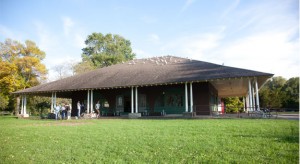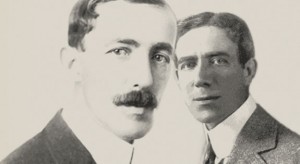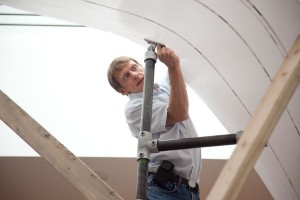Before Ithaca earned its reputation as a college town, it was a city where the early American film industry thrived.

Where children now play on a swing set in Stewart Park, 95 years ago a more common scene would have been a film crew capturing death-defying stunts. Where a couple now picnics on the lawn near Cayuga Lake, brothers Leopold and Theodore Wharton might have been directing a romantic marriage proposal for their next silent film.
The Ithaca Motion Picture Project, a nonprofit organization whose mission is to preserve and renovate the original Wharton Studios building, aims to increase awareness of Ithaca’s film history with the opening of exhibits in eight locations throughout Ithaca. The project details the influence one highly active studio had on the early film era.
In the early 1900s, the two Wharton brothers went to Cornell University to shoot footage of a football game. Given some time to explore the area, the Whartons fell in love with Ithaca’s rolling landscape and decided the city was the perfect location for their new studio and films. In April 1914, during the emergence of the motion picture industry, the Whartons created Wharton, Inc., and rented space in Renwick Park — now known as Stewart Park — to be used for a studio.
Diana Riesman, cofounder of IMPP, said Ithaca citizens could benefit from realizing the importance of the town’s historical involvement in the production of early films.
“People here were pioneers in their time for this kind of thing,” she said. “There are so many aspects of Ithaca’s film history for this museum to potentially highlight.”
Over the next six years, the Whartons produced full-length features and more than 100 episodes for their shorter movies, also called serial films. They made several successful films and episodic serials, most notably “Beatrice Fairfax,” which was made in 1916 and starred famous actors of the time like Harry Fox and Grace Darling.
The Whartons were the first film directors to establish their own studio as independent producers. But, because of financial problems the brothers were forced to abandon their studio in 1919. Leopold moved to San Antonio, Texas, and Theodore went to Hollywood, where he continued to work on films. The brothers’ abandoned studio still stands in Stewart Park today. Should the exhibit prove successful in getting support for the museum, the founders of the IMPP want to use the studio for the museum’s location.
Constance Bruce, cofounder of IMPP, said she supports the idea of eventually turning the old studio into a new museum.

“Ithaca deserves it,” she said. “That building is there, and it’s perfect for creating a motion picture museum so we can always have a destination, and we can always go and see this history.”
Thanks to Wharton, Inc., Ithaca was known as the “Hollywood of the East” during the early 1900s. They also supported the community during World War I by buying bonds and working with the Red Cross. To remind residents how the Whartons helped shape Ithaca’s local history, IMPP plans to use the exhibit to get the entire community involved.
The name of the exhibit, “Romance, Exploits & Peril: When Movies Were Made in Ithaca,” is taken from the titles of the films the Whartons made in the city, such as “A Romance of the Air.” The eight-part exhibit was constructed in the style of sample museum exhibits. If created, the museum would also include an archive of silent films made in Ithaca.
“We want this exhibit to excite people,” Riesman said.
To gain attention and support for the museum, the exhibits are spread throughout Ithaca, six of them downtown, one at the Cayuga Medical Center and one in the Ithaca Tompkins Regional Airport.
The cornerstone of the exhibit will be located in the Tompkins County Public Library, which features an 80-foot sculptural time line of silent film history in Ithaca.
Todd Zwigard, an award-winning architect, said the design inspiration for this piece was a strip of film.
“It’s made out of translucent material so a little bit of light shines through it,” Zwigard said. “It’s strong, but it has a very light feeling.”
The display in Gimme! Coffee was the first one to open Saturday — a wall display with portraits that are part of the IMPP exhibit and also part of the coffee shop’s program featuring community artwork.
Petrune, a vintage clothing shop downtown, was selected for the exhibit because of its prime location on the Commons. Its display focuses on the career and style of Irene Castle, a famous ’20s ballroom dancer, Broadway actress and fashion icon. Zwigard said he designed the eight-part exhibit with local history in mind.

“The designs are a response to that location and how to convey a certain theme within the film history of Ithaca,” he said.
As the IMPP cuts to the next scene of Ithaca’s film history by adding this exhibit to document the past, the group and its supporters hope to educate and enhance the community.
“Ithaca played a very important part in the early development of the film industry,” Zwigard said. “It’s an important legacy for Ithaca that should be preserved.”
The ribbon-cutting ceremony for the “Romance, Exploits & Peril” exhibit will be held at 1 p.m. today at the Tompkins County Public Library.
Romance, Exploits & Peril: When Movies Were Made in Ithaca
Oct. 1 through Nov. 6
Cayuga Medical Center: Comedies and Beatrice Fairfax series
Crescent Building: Sets and special effects
Gimme! Coffee: Photo players wall exhibit
Greater Ithaca Activity Center: Zoetropes with break dancer
Ithaca Tompkins Regional Airport: Film aviation during the 1910s
Petrune: Life and style of Irene Castle
The State Theatre: Tom Bohn’s kinetoscope, film theaters
Tompkins County Public Library: History of film time line




